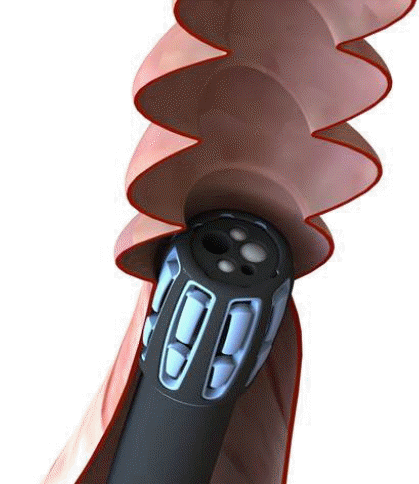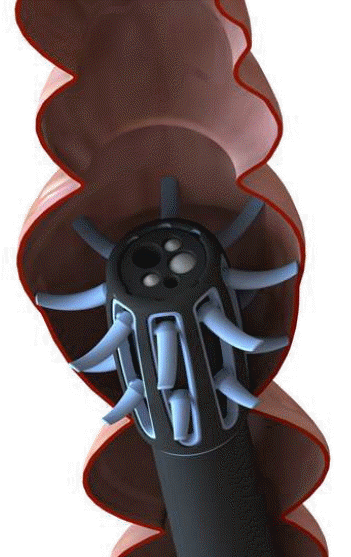1. Sawatzki M, Meyenberger C, Marbet UA, Haarer J, Frei R. Prospective Swiss pilot study of Endocuff-assisted colonoscopy in a screening population. Endosc Int Open. 2015; 3:E236–E239.

2. Floer M, Biecker E, Fitzlaff R, et al. Higher adenoma detection rates with endocuff-assisted colonoscopy: a randomized controlled multi+center trial. PLoS One. 2014; 9:e114267.
3. Lenze F, Beyna T, Lenz P, Heinzow HS, Hengst K, Ullerich H. Endocuff-assisted colonoscopy: a new accessory to improve adenoma detection rate? Technical aspects and first clinical experiences. Endoscopy. 2014; 46:610–614.

4. Chin M, Chen CL, Karnes WE. Improved polyp detection among high risk patients with Endocuff. Gastrointest Endosc. 2015; 81(5 Suppl):AB283.
5. Pioche M, Matsumoto M, Takamaru H, et al. Endocuff-assisted colonoscopy increases polyp detection rate: a simulated randomized study involving an anatomic colorectal model and 32 international endoscopists. Surg Endosc. 2016; 30:288–295.

6. Van Doorn SC, Van Der Vlugt M, Depla AC, et al. Adenoma detection with Endocuff colonoscopy vs conventional colonoscopy: a multicenter randomised controlled trial. Gastrointest Endosc. 2015; 81(5 Suppl):AB145.
7. Marsano J, Tzimas D, Mckinley M, et al. Endocuff assisted colonoscopy increases adenoma detection rates: a multi-center study. Gastrointest Endosc. 2014; 79(5 Suppl):AB550.
8. Biecker E, Floer M, Heinecke A, et al. Novel endocuff-assisted colonoscopy significantly increases the polyp detection rate: a randomized controlled trial. J Clin Gastroenterol. 2015; 49:413–418.
9. Heresbach D, Barrioz T, Lapalus MG, et al. Miss rate for colorectal neoplastic polyps: a prospective multicenter study of back-to-back video colonoscopies. Endoscopy. 2008; 40:284–290.

10. Rastogi A, Bansal A, Rao DS, et al. Higher adenoma detection rates with cap-assisted colonoscopy: a randomised controlled trial. Gut. 2012; 61:402–408.

11. Uraoka T, Tanaka S, Matsumoto T, et al. A novel extra-wide-angle-view colonoscope: a simulated pilot study using anatomic colorectal models. Gastrointest Endosc. 2013; 77:480–483.

12. Gralnek IM, Carr-Locke DL, Segol O, et al. Comparison of standard forward-viewing mode versus ultrawide-viewing mode of a novel colonoscopy platform: a prospective, multicenter study in the detection of simulated polyps in an in vitro colon model (with video). Gastrointest Endosc. 2013; 77:472–479.

13. Hewett DG, Rex DK. Miss rate of right-sided colon examination during colonoscopy defined by retroflexion: an observational study. Gastrointest Endosc. 2011; 74:246–252.

14. de Wijkerslooth TR, Stoop EM, Bossuyt PM, et al. Adenoma detection with cap-assisted colonoscopy versus regular colonoscopy: a randomised controlled trial. Gut. 2012; 61:1426–1434.

15. Gralnek IM. Emerging technological advancements in colonoscopy: Third Eye® Retroscope® and Third Eye® Panoramic™, Fuse® Full Spectrum Endoscopy® colonoscopy platform, Extra-Wide-Angle-View colonoscope, and NaviAidTM G-EYE™ balloon colonoscope. Dig Endosc. 2015; 27:223–231.
16. Hasan N, Gross SA, Gralnek IM, Pochapin M, Kiesslich R, Halpern Z. A novel balloon colonoscope detects significantly more simulated polyps than a standard colonoscope in a colon model. Gastrointest Endosc. 2014; 80:1135–1140.

17. Shpak B, Halpern Z, Kiesslich R, Moshkowitz M, Santo E, Hoff man A. A novel balloon-colonoscope for increased polyp detection rate: results of a randomized tandem study. United Eur Gastroenterol J. 2013; 1(Suppl 1):A87.
18. Gralnek IM, Suissa A, Domanov S. Safety and effi cacy of a novel balloon colonoscope: a prospective cohort study. Endoscopy. 2014; 46:883–887.




 PDF
PDF Citation
Citation Print
Print




 XML Download
XML Download